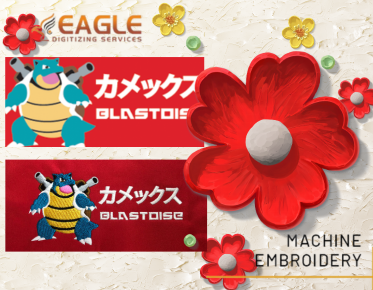Ready to Dive In? How Can I Start Embroidery Digitizing Professionally
In recent years, embroidery digitizing has emerged as a flourishing industry. With a surge in demand for customized and personalized products, the art of transforming designs into stitch files is more relevant than ever. Entrepreneurs and hobbyists alike are discovering that this craft can be not just a passion but a lucrative career path. If you have an eye for design and a knack for technology, diving into the world of embroidery digitizing could be your ticket to a fulfilling profession.
Skills You Need to Get Started
Design Skills: Understanding the Basics of Art and Composition
At the heart of successful embroidery digitizing lies a solid foundation in design. Grasping the fundamentals of art and composition will empower you to create aesthetically pleasing embroidery pieces. This involves understanding color theory, balance, contrast, and how to create harmony within a design. Whether you’re crafting intricate patterns or simple logos, your ability to create visually engaging compositions is essential.
Technical Know-How: Software Proficiency and Machine Knowledge
Embroidery digitizing isn’t just about creativity; it also requires a significant amount of technical skill. Familiarity with digitizing software is crucial, as these programs serve as the bridge between your designs and the final embroidered product. Additionally, understanding how embroidery machines function—knowing their capabilities, limitations, and maintenance—will enhance your effectiveness as a embroidery digitizer.
Attention to Detail: Why Precision is Key in Digitizing
Precision is paramount in the world of embroidery digitizing. Every stitch counts and even the slightest error can lead to disappointing results. A keen eye for detail will help you spot imperfections in your designs and ensure that the final product is executed flawlessly. In this industry, meticulousness separates a good digitizer from a great one.
Mastering Digitizing Techniques
Understanding Underlay Stitches: The Foundation of Every Design
The underlay stitches are the unsung heroes of embroidery digitizing. They provide a foundation that enhances the stability and appearance of the final design. Understanding how to incorporate underlay stitches can prevent puckering and ensure that the top stitches lay smoothly. Learning the intricacies of underlay techniques will elevate your digitizing skills and improve the overall quality of your work.
How to Digitize Text for Clean, Professional Results
Digitizing text requires a delicate touch. Choosing the right font is essential, but translating that font into an embroidery-friendly format is equally important. Pay attention to letter spacing and size, ensuring that the text remains legible and well-defined. Practice different techniques for digitizing text to achieve clean, professional results that stand out.
Techniques for Achieving Depth and Texture in Your Designs
Depth and texture can turn a simple embroidery piece into a stunning work of art. Techniques such as layering stitches, varying density, and using different stitch types can create the illusion of three-dimensionality. Experimenting with these techniques will allow you to craft unique designs that captivate the viewer's attention and showcase your creativity.
Getting the Right Equipment for Your Digitizing Business
Essential Tools You’ll Need: Computers, Digitizing Tablets, and More
Setting up your embroidery digitizing business requires some essential tools. A powerful computer is crucial, as digitizing software demands processing power. Digitizing tablets can enhance your design capabilities, allowing for more precise control over your artwork. Additionally, having a good printer and scanner will assist in preparing and converting designs.
Investing in High-Quality Supplies: Threads, Backing, and Stabilizers
The quality of your materials has a big impact on your results. Invest in high-quality threads, as they not only improve the appearance of your designs but also reduce the chances of breakage during stitching. Choosing the right backing and stabilizers is equally important; they provide support during the embroidery process and enhance the final product's durability.
Setting Up Your Workspace for Success
Creating an Efficient, Organized Workspace for Digitizing
A well-organized workspace can streamline your digitizing process and boost productivity. Ensure that your tools, software, and supplies are easily accessible. Implementing an efficient system for managing your projects will help you stay focused and minimize distractions, enabling you to produce your best work consistently.
Ergonomics and Comfort: How to Avoid Fatigue During Long Hours
Embroidery digitizing can involve long hours of focused work, making ergonomics a vital consideration. Invest in a comfortable chair and desk setup that promotes good posture. To decrease neck and eye strain, position your computer screen at eye level. Taking regular breaks to stretch and move around can also help prevent fatigue, ensuring you remain fresh and productive.
Building a Portfolio of Embroidery Designs
Why Your Portfolio is Your Best Marketing Tool
A well-curated portfolio is your calling card in the embroidery digitizing world. It showcases your skills, creativity, and versatility, allowing potential clients to see the quality of your work. Including a diverse range of styles and techniques will demonstrate your adaptability and attract a wider audience.
Showcasing a Range of Styles and Techniques in Your Work
Your portfolio should reflect your unique style while also highlighting various techniques you’ve mastered. Consider including different types of projects—logos, intricate designs, monograms, and personalized items. A diverse portfolio not only impresses clients but also illustrates your ability to tackle any project that comes your way.
Finding Your Niche in the Market
Specializing in Specific Designs: Logos, Monograms, Apparel, and More
Finding a niche within the embroidery digitizing market can set you apart from the competition. Specializing in specific designs, such as logos, monograms, or apparel, allows you to hone your skills and attract a targeted audience. This focus can lead to higher quality work and more efficient marketing strategies, ultimately elevating your brand.
How Focusing on a Niche Can Help You Stand Out in a Competitive Market
In a crowded marketplace, specialization can be your greatest ally. By concentrating on a specific niche, you can establish yourself as an expert and build a loyal client base. This approach not only enhances your visibility but also enables you to charge premium rates for your specialized services.
Pricing Your Embroidery Digitizing Services
How to Calculate Your Rates Based on Time, Complexity, and Market Demand
Pricing your services can be a daunting task, but it’s crucial for sustaining your business. Start by calculating how much time each project takes and consider the complexity of the designs. To achieve competitive pricing, research local market rates. Balancing affordability with fair compensation for your time and expertise will help you establish a solid foundation for your business.
Pricing Strategies for Beginners: Flat Rate vs. Hourly Pricing
As a beginner, you may wonder whether to charge a flat rate or an hourly fee. Flat rates can simplify the billing process for clients and provide transparency. Hourly rates may be more suitable for complex projects where time is difficult to estimate. Consider your unique situation and choose a pricing strategy that aligns with your goals and client expectations.
Marketing Yourself as a Professional Embroidery Digitizer
Building an Online Presence: Website, Social Media, and Portfolios
In today's digital age, establishing an online presence is essential. Create a professional website showcasing your portfolio, services, and contact information. Utilize social media platforms to share your work, connect with potential clients, and engage with the embroidery community. An online presence not only boosts your visibility but also builds credibility in your field.
Networking with Local Businesses and Embroidery Shops
Networking is an extremely effective method for expanding your organization. Connect with local businesses, embroidery shops, and fellow digitizers to exchange ideas, collaborate, and find potential clients. Attend industry events and join embroidery associations to expand your network and enhance your credibility within the community.
Offering Exceptional Customer Service
How to Communicate with Clients to Understand Their Design Needs
Clear communication is the backbone of exceptional customer service. Take the time to understand your client’s design needs and preferences. Asking the right questions can help clarify their vision and lead to more successful outcomes. Always be open to feedback, as it fosters a collaborative environment that enhances client satisfaction.
Managing Revisions and Edits: Keeping Your Clients Happy
Managing revisions is an inevitable part of the digitizing process. Being flexible and accommodating while keeping the lines of communication open can turn potential frustrations into opportunities for collaboration. Addressing client requests promptly and professionally can leave a lasting impression, ensuring they return for future projects.
Starting Your Own Embroidery Digitizing Business
Legal Considerations: Registering Your Business, Taxes, and Licensing
Starting a professional embroidery digitizing business involves navigating various legal considerations. Register your business and familiarize yourself with local regulations and tax obligations. Understanding licensing requirements is crucial to ensure compliance and protect your intellectual property. Consulting with a legal professional can help guide you through these processes.
Building a Business Plan: Setting Goals and Budgeting for Success
A well-structured business plan acts as your roadmap to success. Outline your goals, marketing strategies, and financial projections to create a comprehensive plan. Budgeting for equipment, software, and other expenses will keep your business on track and help you anticipate challenges as you grow.
Scaling Your Embroidery Digitizing Business
When to Hire Help: Assistants, Designers, or Salespeople
As your business grows, you may find it beneficial to bring in help. Hiring assistants, additional designers, or salespeople can free up your time and allow you to focus on high-priority tasks. Assess your workload and determine when it’s the right time to expand your team to enhance your efficiency and output.
How to Expand Your Services to Include Custom Embroidery or Merchandise
Once you’ve established a steady workflow, consider expanding your services to include custom embroidery or related merchandise. Offering complementary products, such as embroidered apparel or promotional items, can attract new clients and increase your revenue streams. Diversifying your offerings allows for greater flexibility in your business and meets various client needs.
Common Mistakes to Avoid When Starting Out
Overcomplicating Designs: Why Simplicity is Key
A common pitfall for beginners is overcomplicating designs. Remember that simplicity often translates to elegance in embroidery. Designs that are too intricate can lead to confusion during the digitizing process and may not translate well onto fabric. Focusing on clear, concise designs will yield better results and appeal to a broader audience.
Ignoring the Importance of Testing Your Designs Before Production
Testing your designs before production is crucial to ensuring quality. Ignoring this step can lead to costly errors and dissatisfied clients. Run a few test stitches to identify any potential issues and make adjustments as needed. This diligence not only saves time but also enhances your reputation for producing high-quality work.
Embarking on a professional journey in embroidery digitizing in USA is an exciting venture filled with opportunities for creativity and entrepreneurship. With the right skills, tools, and mindset, you can turn your passion into a thriving career. Remember that practice is essential; continue honing your craft and developing your unique style. As you progress, the world of embroidery digitizing will open up endless possibilities for artistic expression and professional success.



